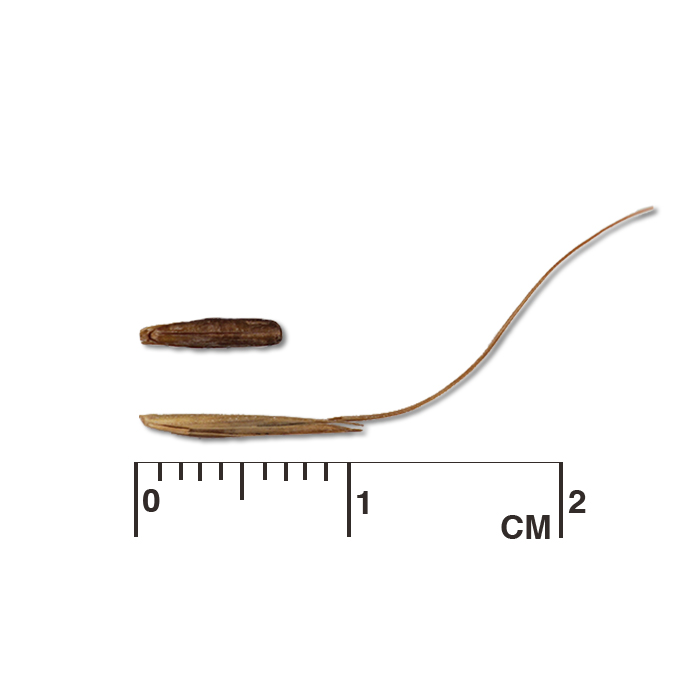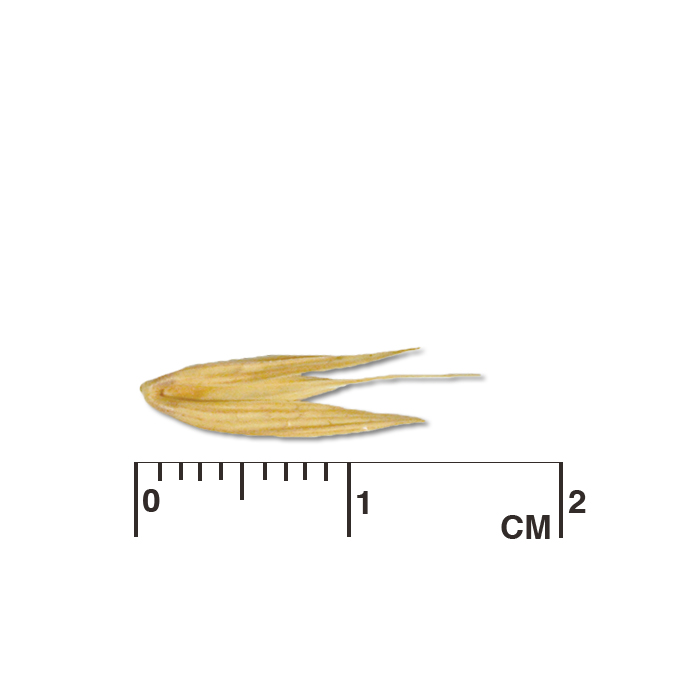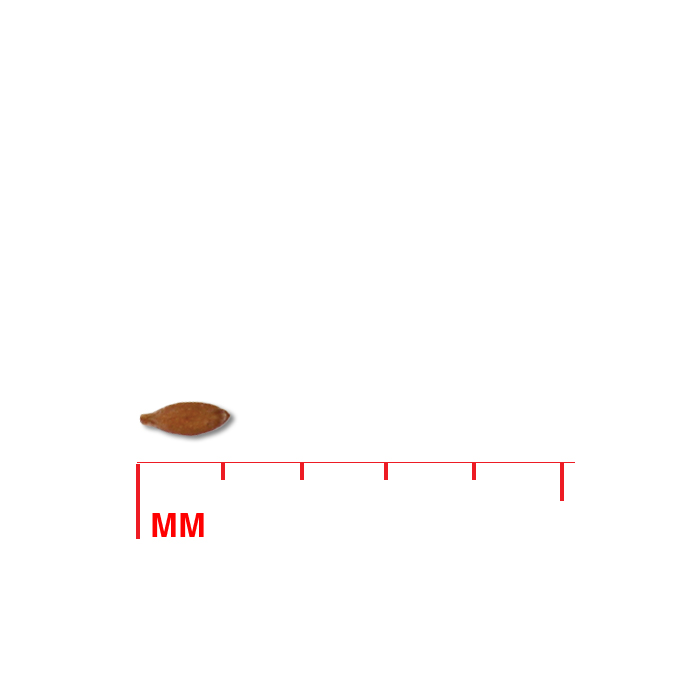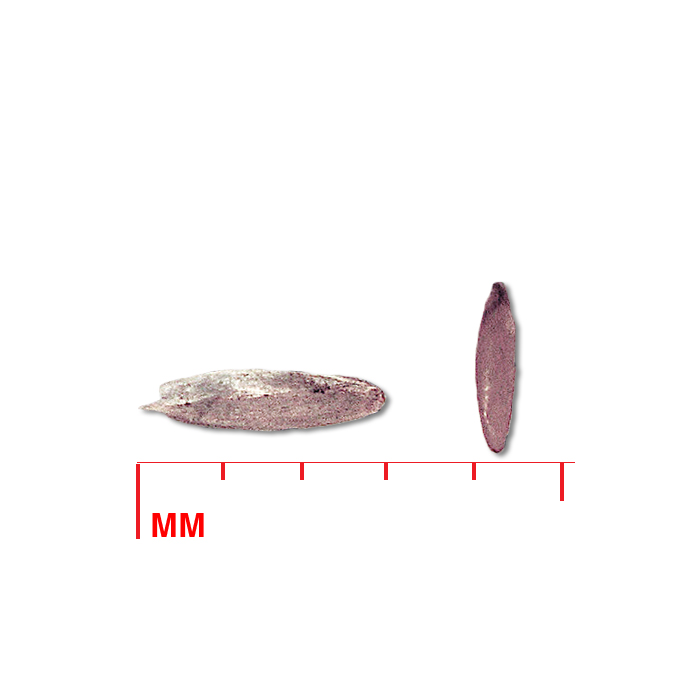Cool Season Grasses
Cool Season Grasses sagemThe Species Production Guides for cool season grasses provide specific information about growing each of these species for seed production.
A printable file (pdf) is also provided on each species page for those needing a print version.
This section is a work in progress. We will continue to add new species guides as they are completed.
Festuca paradoxa / clustered fescue
Glyceria striata / fowl mannagrass
Hesperostipa spartea / porcupinegrass
Canada wildrye
Canada wildrye dickeye
Elymus canadensis L.
Alternate Common Name(s): nodding wildrye, western wildrye, great plains wildrye
Scientific Synonym(s): Elymus brachystachys Scribn. & C.R. Ball, Elymus canadensis L. var. brachystachys (Scribn. & C.R. Ball) Farw., Elymus canadensis L. var. hirsutus (Farw.) Dorn, Elymus canadensis L. var. robustus (Scribn. & J.G. Sm.) Mack. & Bush, Elymus crescendus L.C. Wheeler, Elymus philadelphicus L., Elymus philadelphicus L. var. hirsutus Farw., Elymus robustus Scribn. & J.G. Sm.
Family: grass family (Poaceae)
Functional Group: cool season grasses
Printable PDF Elymus canadensis
PDF will be added soon
Description
- Life cycle and growth form
Perennial, cool-season bunchgrass, weak to no rhizomes.
Height: 1-5 ft
- Leaves and stem
Leaf blades up to 16 in long, 1/4-3/4 in wide, ligule a short (up to 1 mm) membrane, sheaths usually smooth with two small, purplish to brown lobes (auricles) clasping stem where the sheath meets the blade, nodes hairless and hidden under the sheaths; stems smooth, erect, unbranched.
- Flower, fruit and seedhead
Fruit/seedhead: Seedhead a thick, bristly spike, 3-10 inches long, usually nodding, light tan when mature, each spikelet with a pair of awned glumes (up to 1.5 in including the awn) and 3-5 florets, lemmas (chaffy parts around the grain) also awned (up to 2.5 in including the awn), awns twist and curve outward when dry, florets drop when mature, leaving glumes on the stalk.
Pollination: wind
- Seed
Seed characteristics
Seeds per ounce: 5,200 (IA NRCS)
Seeds per pound: 83,200 (IA NRCS)
1000 seed weight: 4.50 g (Seed Information Database)
Description: The long, barbed awns make this species difficult to clean. Curved awns on lemmas are up to 5 cm (2 in). Glumes taper to awns 1-3 cm (1/2-1.25 in) long. Caryopsis dark brown at maturity, 5-8 mm long.
Typical seed test
PLS: 88%
Purity: 96%
Germination: 66%
Dormant: 19%
(averages obtained from 12 tests of purchased seed lots)
- Habitat and range
Habitat: Broadly adapted to a range of conditions: dry to moist soil; partial to full sun; prairies, savannas, woodland edges, bluffs, dunes, riverbanks, upland and lowland, open areas, disturbed areas. Wetland Indicator Status is Facultative Upland (FACU) for the Midwest. Well-drained, loamy soils are preferred for production.
Conservation status: Global- G5, secure; Maine- SH, possibly extirpated; Nevada and Virginia- S1, critically imperiled (NatureServe)
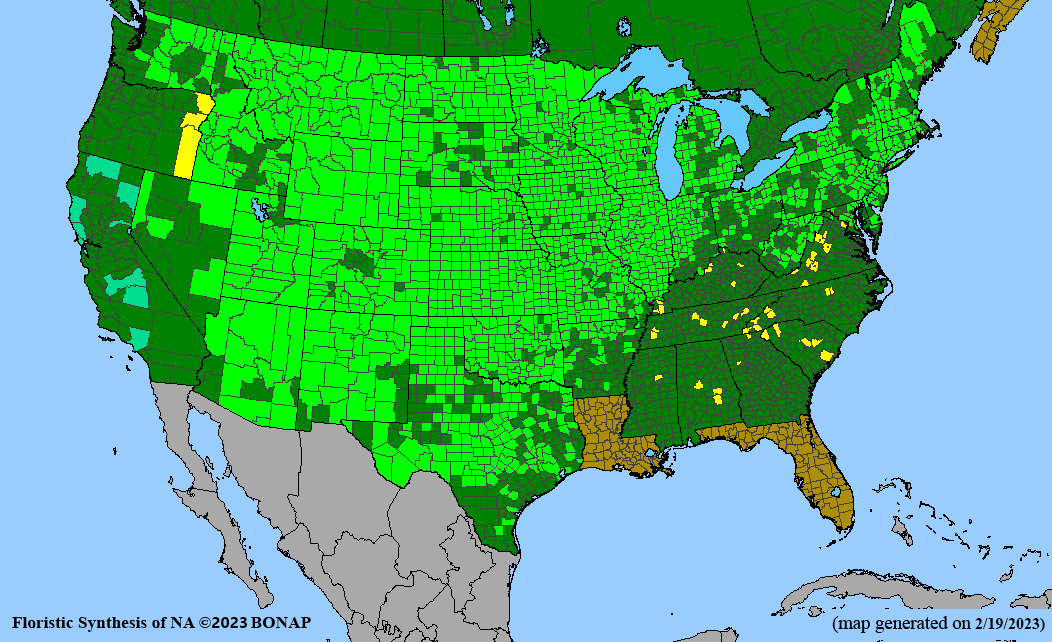
General Comments
Canada wildrye is a relatively short-lived perennial bunchgrass which establishes readily from seed in mixed plantings. These two traits make it ideally suited as a nurse crop for prairie restorations. It can also be direct-seeded as a seed production field into a well-prepared, weed-free seed bed (e.g., following a glyphosate-resistant crop).
Recommendations for Seed Production
- Establishment for seed production
Direct seeding
Row spacing: 36 in 24 in 12 in solid stand PLS lbs/acre: 7 10.5 21 21 Seeding depth: 1/4-1/2 in
Seeding method: native seed drill
Seeding time: Fall, or early spring preferred.
Weed control: Prepare clean, firm, weed free seedbed prior to seeding.
Greenhouse
Seed pre-treatment: No stratification necessary. Germination of grass seed usually improves with proper storage (cool, dry conditions) throughout the first year after harvest.
Sowing: Sow seed in greenhouse two months before last frost free date at 1/4 in depth.
Transplanting: Transplant at 12 in spacing in prepared beds after all danger of frost.
- Stand management
Weeds: Mow stands high (6–12 in) first growing season to prevent weed canopy from shading seedlings. Broadleaf herbicides can be used to control broadleaf weeds in established stands.
Pests: None noted.
Diseases: Susceptible to leaf and stem rust, also ergot.
Hybridization risk: This species is known to hybridize with related species Elymus hystrix, E. villosus, E. virginicus
- Seed production
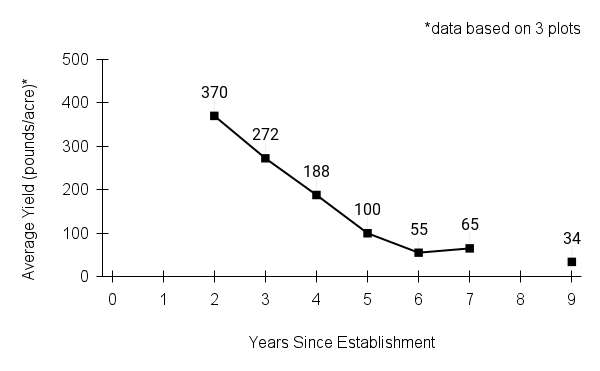
First harvest: Flowering and seed set will occur at the end of the first growing season from previous fall seeding or early spring seeding, or late spring transplants.
Yield: 35-370 bulk pounds/acre (per acre yield extrapolated from 3 plots)
Stand life: 4-6 years. Seed production declines significantly in the fifth year and after. Annual fall burning will prolong stand life and seed yield.
Flowering date: mid-July to mid-August in northern Iowa
Seed maturity/Harvest date: September in northern Iowa
Seed retention: shattering occurs early to mid-October
Harvest date range at TPC (2003-2010): Sept 7 - Nov 4
Recommended harvest method: Combine at maturity (hard dough stage). Long, barbed awns make harvesting a challenge, causing seed to ball up and not flow. Additional de-awning bars or other modifications to the combine may be required for successful harvest of this species.
- Seed cleaning and storage
Cleaning process: Debeard or brush to remove long awns and make the material flowable. Air-screen to clean (See Appendix C for settings).
Seed storage: cool/dry (33-50° F, 30-50% RH)
Released Germplasm
Source Identified material: Central Iowa Germplasm (IA Zone 2), Northern Iowa Germplasm (IA Zone 1), Southern Iowa Germplasm (IA Zone 3)
Selected Germplasm: Lavaca Germplasm (TX)
Cultivated variety (cultivar): Mandan (ND)
Tested: Icy Blue Germplasm (MI)
- References
Barkworth, M. E., Campbell, J. J.N., & Salomon, B. (2021, May 11). Elymus canadensis L. Flora of North America. http://floranorthamerica.org/Elymus_canadensis
Chayka, K. (n.d.). Elymus canadensis (Canada wild rye). Minnesota Wildflowers. https://www.minnesotawildflowers.info/grass-sedge-rush/canada-wild-rye
Cochrane, T. S., Elliot, K., & Lipke, C. S. (2014). Canada wild-rye. In Prairie plants of the University of Wisconsin-Madison Arboretum (3rd ed., p. 264). University of Wisconsin-Madison Arboretum.
Great Plains Flora Association. (1991). Grass family. In T. M. Barkley, R. E. Brooks, & E. K. Schofield (Eds.), Flora of the Great Plains (2nd ed., p. 1167). University Press of Kansas.
Houseal, G. A. (2007). Grasses cool season. In G. A. Houseal (Eds.), Tallgrass Prairie Center’s native seed production manual (pp. 84–85). Tallgrass Prairie Center - University of Northern Iowa.
Kartesz, J.T., The Biota of North America Program (BONAP). 2023. North American Plant Atlas. (http://bonap.net/napa). Chapel Hill, N.C. [maps generated from Kartesz, J.T. 2023. Floristic Synthesis of North America, Version 1.0. Biota of North America Program (BONAP). (in press)]
NatureServe. 2024. NatureServe Network Biodiversity Location Data accessed through NatureServe Explorer [web application]. NatureServe, Arlington, Virginia. Available https://explorer.natureserve.org/. (Accessed: February 29, 2024).
USDA NRCS National Plant Data Team. (n.d.). Elymus canadensis L. USDA plants database. https://plants.usda.gov/home/plantProfile?symbol=ELCA4
Species Guide Updated 01/31/2025
Virginia wild rye
Virginia wild rye dickeye
Elymus virginicus L.
Alternate Common Name: Terrell grass
Family: grass family (Poaceae)
Functional Group: cool season grasses
Description
- Life cycle and growth form
Perennial, cool season bunchgrass with fibrous roots.
Height: 1-4 ft
- Leaves and stem
Leaf blades mostly flat but sometimes with inrolled edges, rough textured, 12-35 cm (5-14 in) long and 5-15 mm (1/4-5/8 in) wide, sheath sometimes with fine hairs; ligule a short membrane bracketed by two small, often purplish projections (auricles) that may wrap partway around the stem. Stems unbranched, smooth and erect, multiple from the base making clumps.
- Flower, fruit and seedhead
Fruit/seedhead: Seed head is an erect spike 5-17 cm (2-7 in) long (distinguishing it from Canada wildrye which has drooping spikes), often partially enclosed in the uppermost, inflated leaf sheath, light straw-colored at maturity. Spikelets bear awns up to 1 in long. Spikelets eventually drop off, leaving a naked stalk with alternating nodes.
Pollination: wind
- Seed
Seed characteristics
Seed weight:
Seeds per ounce: 4,200 (IA NRCS)
Seeds per pound: 67,200 (IA NRCS)
1000 seed weight: 6.14 g (Seed Information Database)
Description: Typical seed unit is a spikelet with 2-3 florets, awned, 0.5-2 cm (1/4-7/8 in) long including awns. Empty scales (glumes) on either side of spikelet thickened, rigid, awned, up to 2.5 cm long (1 in) long including awn. Awn length is highly variable in this species.
Typical seed test
PLS: 96%
Purity: 98%
Germination: 48%
Dormant: 51%
(averages obtained from 9 tests of purchased seed lots)
- Habitat and range
Habitat: Mesic to wet-mesic soil with high fertility; light shade to full sun; deciduous forests, savannas, thickets, meadows near woodlands. Wetland Indicator Status is Facultative Wetland (FACW) for the Midwest. Well-drained loams are preferred for seed production.
Conservation status: Global- G5, secure (NatureServe)

General Comments
Virginia wildrye is commonly found in open forests, savannas, and along woodland edges, and can be particularly abundant in open forests along creeks and rivers. It readily establishes from seed, and holds promise as a nurse crop for prairie and savanna reconstructions. Because of its shade tolerance, it will spread in open woodlands, but eventually gives way to full-sun adapted prairie species in a prairie reconstruction.
Recommendations for Seed Production
- Establishment for seed production
Direct seeding
Row spacing: 36 in 24 in 12 in Solid Stand PLS lbs/acre: 8.6 11.5 23 20-35 Seeding depth: 1/4-1/2 in
Seeding method: native seed drill
Seeding time: Fall or early spring
Weed control: Prepare clean, firm, weed free seedbed prior to seeding (e.g., following a glyphosate-resistant crop, for example).
Greenhouse
Seed pre-treatment: No moist stratification is necessary. Germination of grass seed usually improves with proper storage (cool, dry conditions) throughout the first year after harvest.
Sowing: Sow seed in greenhouse two months before last frost free date at 1/4-1/2 in depth.
Transplanting: Transplant after all danger of frost into rows spaced convenient for tillage equipment or at 12 in spacing in a weed barrier.
- Stand management
Weeds: Mow stands high (6-12 in) first growing season to prevent weed canopy from shading seedlings. Broadleaf herbicides can be used to control broadleaf weeds in established stands. Cultivate or mow between rows.
Pests: Grubs are reportedly a problem in Texas.
Diseases: Ergot is known to occur on seedheads.
Hybridization risk: This species is known to hybridize with related species Elymus canadensis, E. hystrix, E. villosus. Maintain adequate separation between plots of these species.
- Seed production
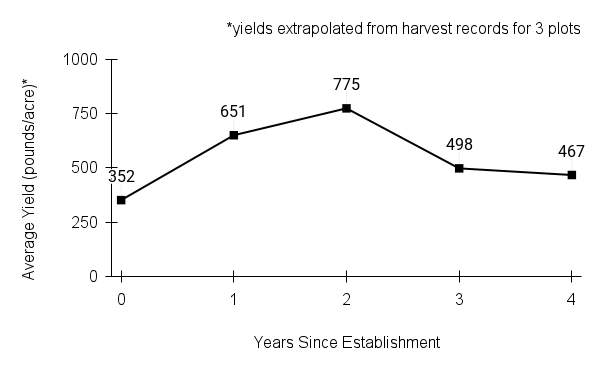 First harvest: Abundant flowering and seed set end of first growing season from greenhouse grown plugs transplanted into a weed barrier.
First harvest: Abundant flowering and seed set end of first growing season from greenhouse grown plugs transplanted into a weed barrier.Yield: 355-775 bulk pounds/acre (per acre yields extrapolated from production on 3 plots)
Stand life: Estimated stand life 5-8 years. Annual early spring burn will prolong the life of the stand.
Flowering date: mid-July to mid-August in northern Iowa
Seed maturity/Harvest date: late August to early September in northern Iowa
Seed retention: Shattering occurs mid to late October; fairly low risk of seed loss.
Harvest date range at TPC (2006-2025): Aug 14 - Nov 22
Harvest date range at Elsberry, MO: Aug 29 to Sept 12
Recommended harvest method: Combine at hard dough stage.
- Seed cleaning and storage
Cleaning process: Pre-clean air-dried material by scalping through 1/2 in mesh to remove large chopped stems and leaves. Debeard or brush gently to remove awns and break up seed heads, then airscreen to clean (see Appendix C for settings).
Seed storage: cool/dry (33-50° F, 30-50% RH).
Released Germplasm
Source Identified material: Natural Selections/Iowa Ecotype Project Zones 1, 2, and 3. Northern Missouri Germplasm
Selected Germplasm: Cuivre River Germplasm (MO), Kinchafoonee Germplasm (TX), Tober Germplasm (ND)
- References
Chayka, K. (n.d.). Elymus virginicus (Virginia wild rye). Minnesota Wildflowers. https://www.minnesotawildflowers.info/grass-sedge-rush/virginia-wild-rye
Hilty, J. (2019). Virginia wild rye - Elymus virginicus. Illinois Wildflowers. https://www.illinoiswildflowers.info/grasses/plants/va_rye.htm
Houseal, G. A. (2007). Grasses cool season. In G. A. Houseal (Eds.), Tallgrass Prairie Center’s native seed production manual (pp. 86–87). Tallgrass Prairie Center - University of Northern Iowa.
Kartesz, J.T., The Biota of North America Program (BONAP). 2023. North American Plant Atlas. (http://bonap.net/napa). Chapel Hill, N.C. [maps generated from Kartesz, J.T. 2023. Floristic Synthesis of North America, Version 1.0. Biota of North America Program (BONAP). (in press)]
NatureServe. 2024. NatureServe Network Biodiversity Location Data accessed through NatureServe Explorer [web application]. NatureServe, Arlington, Virginia. Available https://explorer.natureserve.org/. (Accessed: February 29, 2024).
USDA NRCS National Plant Data Team. (n.d.). Elymus virginicus L. USDA plants database. https://plants.usda.gov/home/plantProfile?symbol=ELVI3
Species Guide Updated 12/3/2025
arctic brome
arctic brome dickeye
Bromus kalmii, A. Gray
Alternate Common Names: Kalm’s brome, prairie brome
Scientific Synonyms: Bromopsis kalmii (A. Gray) Holub, Bromus purgans auct. non L, Bromus purgans L., nom. utique rej.
Family: grass family (Poaceae)
Functional Group: cool season grass
Description
- Life cycle and growth form
Short-lived, perennial cool-season grass that grows in distinct tufts or bunches. (In contrast, smooth brome (Bromus inermis) spreads vigorously by rhizomes, and other weedy or invasive brome species are annuals.)
Height: 2 ft
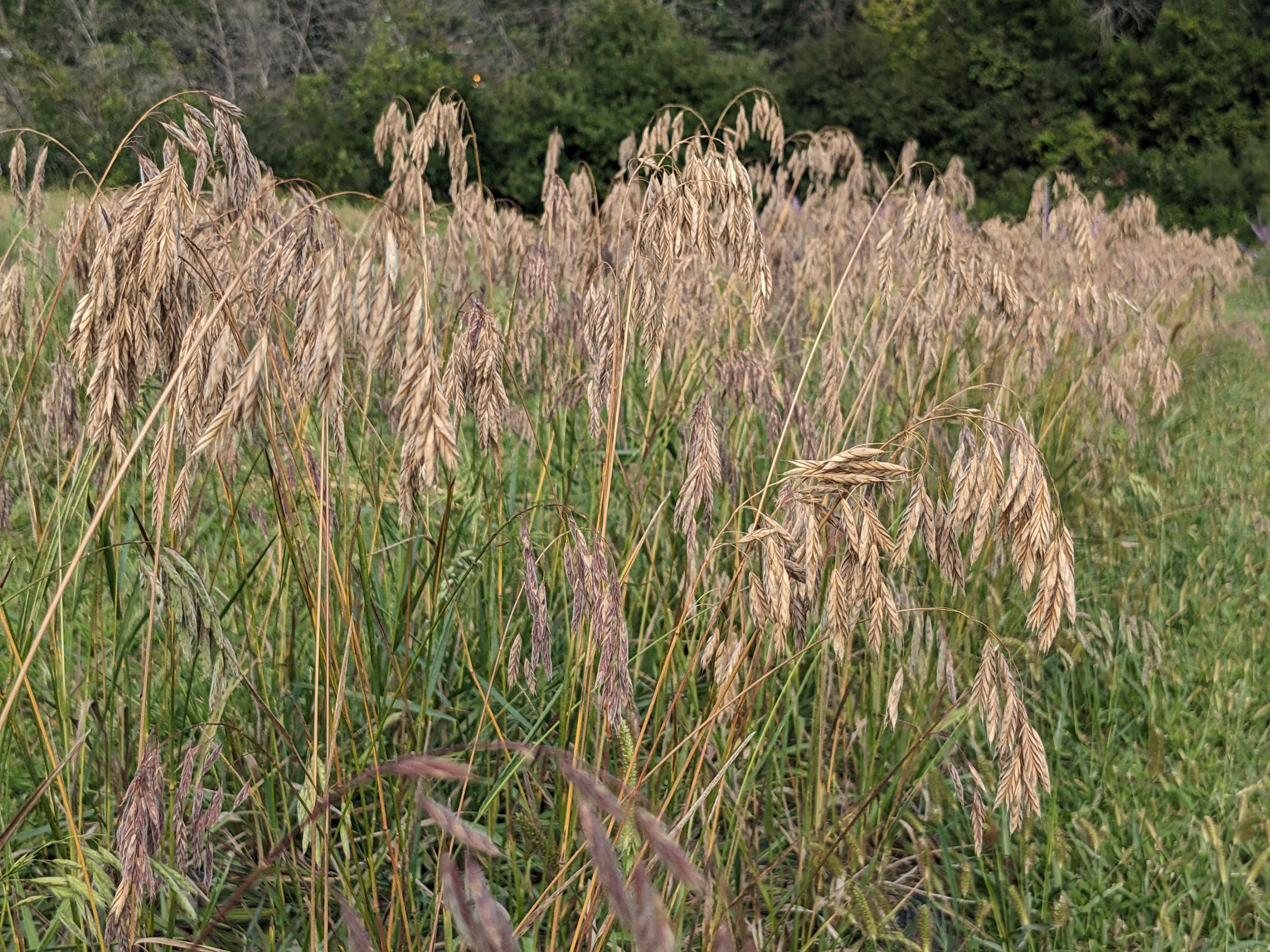
- Leaves and stem
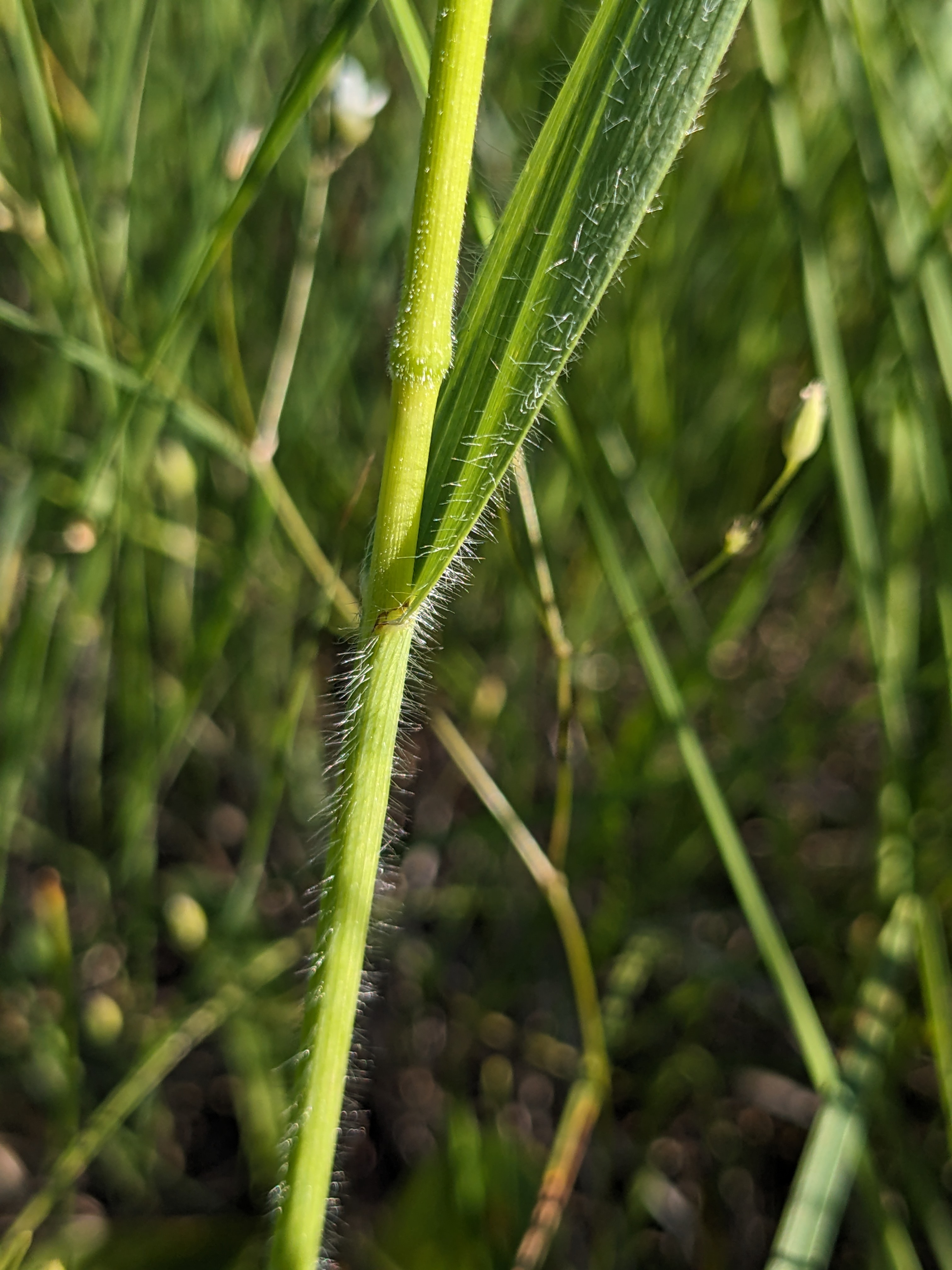
Leaves have flat blades, 3-10 in long and about 3/8 in wide, often hairy, especially near the margins and along the mid-rib; lower sheaths covered in long hairs; flowering stems (culms) are smooth, with short, dense, downward-pointing hairs at the nodes. Note that the leaves of the introduced annual bromes such as cheatgrass are generally narrower than those of arctic brome.
- Flower, fruit and seedhead
Fruit/seed head: Seedhead is a loose panicle that nods gracefully to one side, 4 to 6 in long, bearing spikelets composed of up to 10 florets that are densely hairy and have short awns (2-3 mm). The easily visible hairiness of the spikelets help to distinguish this species from smooth brome and the shorter awns differentiate it from other weedy or invasive members of the genus.
Pollination: wind
- Seed
Seed characteristics
Seed weight:
Seeds per ounce: 8,000 seeds (IA NRCS)
1000 seed weight: 2.55g (Seed Information Database)
Description: Grains are strongly flattened and ovoid, 6-8 mm long, with a bundle of white hairs at the tip, enclosed in hairy bracts (lemma and palea)
Typical seed test
PLS: 85%
Purity: 90%
Germination: 25%
Dormancy: 61%
(averages obtained from 11 tests of purchased seed lots)
- Habitat and range
Habitat: Dry to moist soil; partial to full sun; prairies, prairie remnants, meadows, fens, savannas, open woodlands; Wetland Indicator Status is Facultative (FAC) for the Midwest; mesic to dry well-drained loamy soils are recommended for seed production.
Conservation status: Global- G5, secure; District of Columbia, Maryland, and New Hampshire- SH, possibly extirpated; Maine and Virginia- S1, critically imperiled; New Jersey, Ohio, Pennsylvania, and Vermont- S2, imperiled; Illinois- S2/S3, imperiled to vulnerable; Iowa and North Dakota- S3, vulnerable (NatureServe)
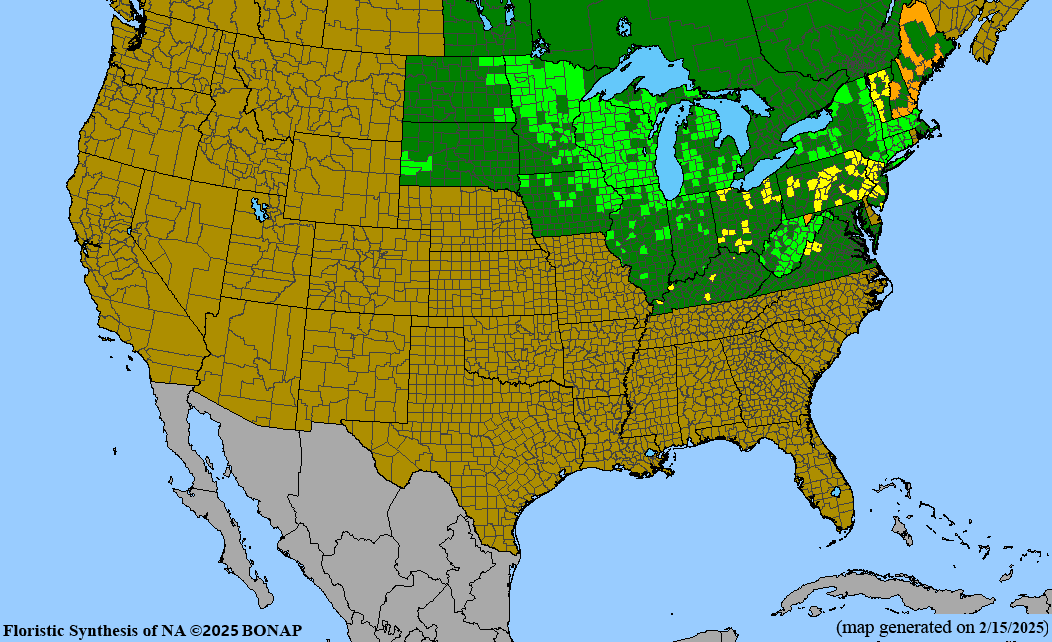
General Comments
The name “brome” is not one that most prairie restoration practitioners hope to see in plant lists due to their familiarity with the highly competitive, invasive, sod-forming species, smooth brome. However, native species in the genus Bromus such as Bromus kalmii (called “arctic brome” using USDA Plants nomenclature or more commonly “prairie brome” or “Kalm’s brome”) are valuable additions to restoration seed mixes in the Upper Midwest and northern Great Plains through the Northeast. Arctic brome is distinguishable from smooth brome by its clumping, nonrhizomatous growth habit and the preponderance of soft hairs on its leaf sheaths, leaves (often), stem nodes, and seedheads. Plantings by the Tallgrass Prairie Center have included this grass since at least 2016, and monitoring shows that it establishes and persists in planted prairies in our area and coexists alongside other grasses and forbs. Iowa Source Identified arctic brome provides regionally appropriate material for another option to fill the cool season graminoid component of seed mixes. This is also an elegant and shorter statured native grass for landscape design applications.
Recommendations for Seed Production
- Establishment for seed production
Direct seeding
Direct seeding methods shared by a commercial native seed grower
Seeding rate: 15 pounds/acre
Row spacing: solid stand
Seeding depth: surface
Seeding method: broadcast
Seeding time: dormant season
Weed control: Prepare clean, firm, weed free seedbed prior to seeding (e.g., following a glyphosate-resistant crop, for example).
Greenhouse
Seed pre-treatment: Cold/moist stratification for 30 days produced even germination.
Sowing: Lightly cover seed in germination flats or plugs in the greenhouse about 8-12 weeks before average frost free date. Germination begins about one week after sowing.
Transplanting: When plugs are well-rooted, move them outside to harden off for a week or two, then transplant into plastic mulch with 8-12 in spacing between plants after danger of frost is past.
- Stand management
Weeds: If direct seeded, mow stands high (6-12 in) during the first growing season to prevent weed canopy from shading seedlings. We do not currently have information on herbicides that could be used for weed control in this crop. Cultivate or mow between rows. Hand rogue before harvest to remove potential weed seed contaminants.
Pests: None noted.
Diseases: None noted.
- Seed production
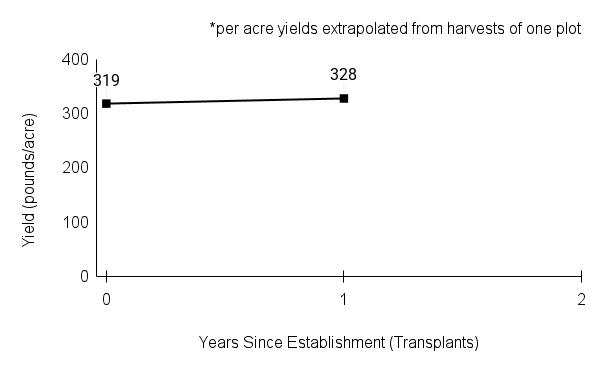 First harvest: Flowering and seed set in first growing season from transplants; probably in the second year from direct seeding.
First harvest: Flowering and seed set in first growing season from transplants; probably in the second year from direct seeding.Yield/acre: About 320 pounds/acre (extrapolated from two years of harvests of one production plot).
Stand life: Unknown at this time but likely 3-5 years. Invasion of plot by non-native cool season grasses (quack grass and smooth brome) seems to be the greatest challenge.
Flowering date: June to July in northeast Iowa
Seed maturity/harvest date: mid to late July in northeast Iowa (first year harvests from transplants are delayed into September)
Seed retention: Seed is relatively resistant to shattering, though high winds and rain can cause some loss of seed. Frequent monitoring recommended as seed matures. In remnant prairies, we observed that some seed remained on plants well into September.
Harvest date range at TPC (2024 - 2025): July 14 to Sept 3 (September date was in the first growing season)
Recommended harvest method: combine
- Seed cleaning and storage
Cleaning process: Scalp material through 1/2 in mesh if needed to remove larger debris. Brush material to make it more flowable, then airscreen. Indent, if needed, to remove shorter seeded weeds.
Seed storage: cool/dry (33-50° F, 30-50% RH)
Released Germplasm
Source Identified material: Natural Selections/Iowa Ecotype Zone EA (eastern Iowa)
- References
Chayka, K. (n.d.). Bromus kalmii (Kalm’s brome). Minnesota Wildflowers. https://www.minnesotawildflowers.info/grass-sedge-rush/kalms-brome
Hilty, J. (2019). Prairie brome - Bromus kalmii. Illinois Wildflowers. https://www.illinoiswildflowers.info/grasses/plants/pr_brome.htm
NatureServe. 2024. NatureServe Network Biodiversity Location Data accessed through NatureServe Explorer [web application]. NatureServe, Arlington, Virginia. Available https://explorer.natureserve.org/. (Accessed: February 28, 2024).
Pavlickf, L. E. (2021, May 11). Bromus kalmii A. Gray. Flora of North America. http://floranorthamerica.org/Bromus_kalmii
USDA NRCS National Plant Data Team. (n.d.). Bromus kalmii A. Gray. USDA plants database. https://plants.usda.gov/home/plantProfile?symbol=BRKA2
Species Guide Updated 12/17/2025
bluejoint
bluejoint dickeye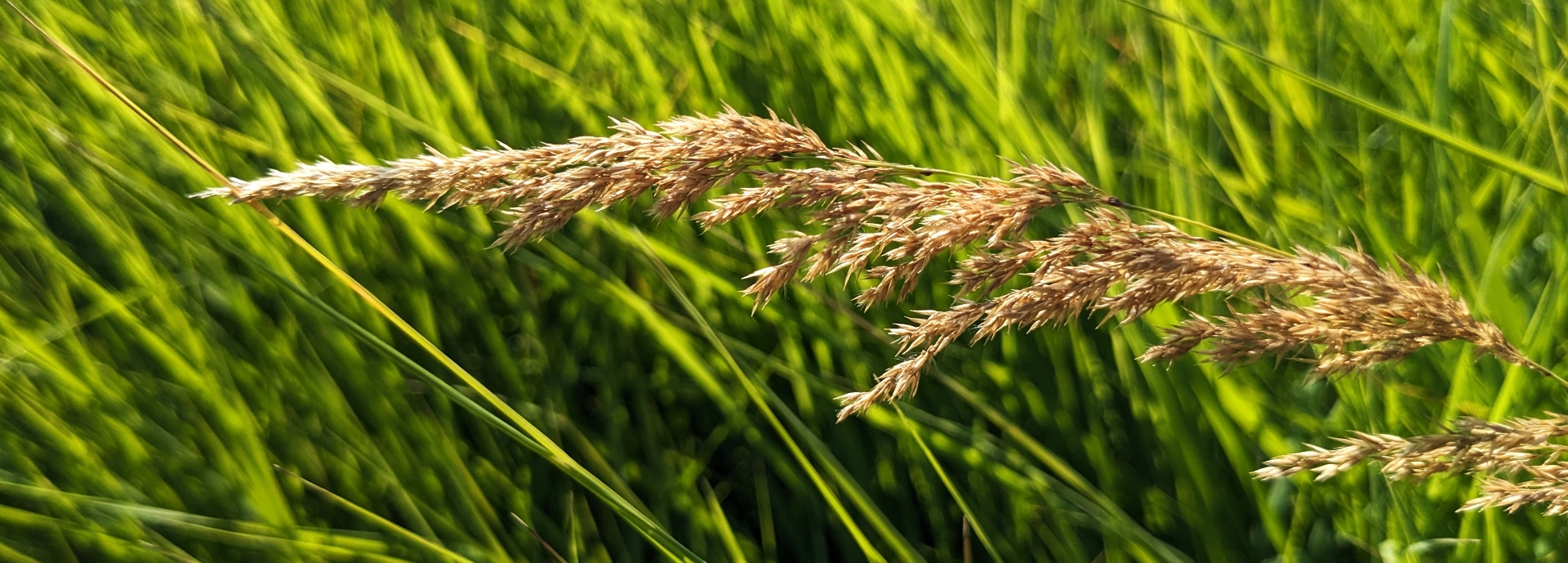
Calamagrostis canadensis (Michx) P. Beauv.
Alternate Common Names: bluejoint reedgrass, Canada bluejoint, Canada reedgrass, marsh reedgrass, meadow pinegrass
Scientific Synonym: Calamagrostis anomala
Family: grass family (Poaceae)
Functional Group: cool season grasses
Description
- Life cycle and growth form
Perennial, rhizomatous grass that forms spreading, hummocky colonies.
Height: Flowering culms 3-5 ft tall
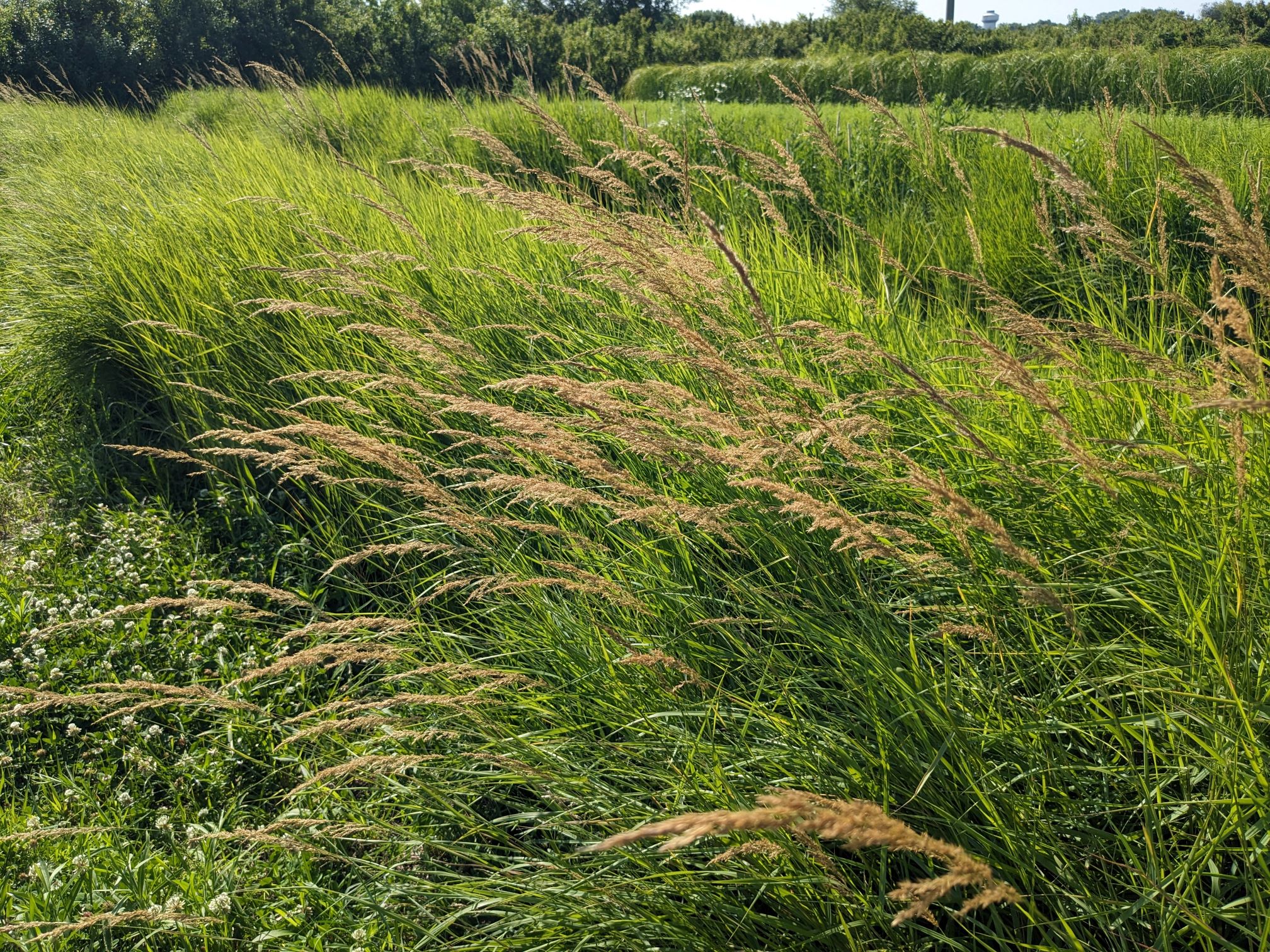
- Leaves and stem
Leaf blades up to 12 in (30 cm) long and 3/16-3/8 in (3-8 mm) wide, leaf sheaths smooth with prominent veins; ligule is membranous, about 1/8 in (3 mm) tall; stems and nodes are hairless; dead leaves and stems accumulate from year to year in absence of fire, forming tussocks.
- Flower, fruit and seedhead
Fruit/seedhead: Mature seed head is a pale gold, loosely branched, plume-like panicle 4-8 in long (10-20 cm), tending to nod to one side; short “flag leaf” just below panicle tends to stick out at a 90 degree angle from the stem; florets fall off when mature, leaving glumes on the stalks.
Pollination: Wind
- Seed
Seed characteristics
Seed weight:
Seeds per ounce: 280,000 (IA NRCS)
Seeds per pound: 4,480,000 (IA NRCS)
1000 seed weight: 0.32 g (Seed Information Database)
Description: Spikelets about 2 mm (3/32 in) long. Grain (caryopsis) about 1/32-1/16 in (1 mm) long, with tuft of hairs at the base slightly shorter than the grain.
Typical seed test
PLS: 90%
Purity: 95%
Germination: 73%
Dormant: 22%
(averages obtained from 4 tests of purchased seed lots)
- Habitat and range
Habitat: Wet-mesic to wet soil; full sun; bogs, marshes, wet swales, along rivers and streams. Tolerates acidic soils up to pH 8 conditions; can tolerate anaerobic (low oxygen) conditions; prefers nutrient-rich, seasonally-inundated soils; irrigation is essential for optimal seed production on upland sites. Wetland Indicator Status is Obligate Wetland (OBL) for the Midwest.
Conservation status: Global- G5, secure; North Carolina, Delaware, and Kansas- S1, critically imperiled; Illinois- S3, vulnerable (NatureServe)
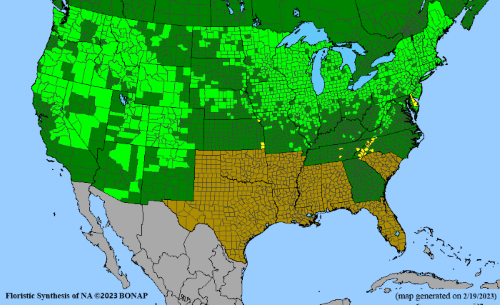
General Comments
Bluejoint is a highly rhizomatous species forming large colonies in preferred habitats, occupying sites even more wet than prairie cordgrass (Spartina pectinata) seems to prefer. Like prairie cordgrass, seed production occurs mostly on the outer edges of colonies, and is generally low. Bluejoint is best propagated in controlled conditions of the greenhouse, and transplanted into wide row spacings.
Recommendations for Seed Production
- Establishment for seed production
Direct seeding
Not recommended for this species
Greenhouse
Seed pre-treatment: No stratification necessary. Germination of grass seed usually improves with proper storage (cool, dry conditions) throughout the first year after harvest.
Sowing: Sow seed on surface of growing mix in greenhouse two months before last frost free date. Water carefully with a mist wand to avoid dislodging seed.
Transplanting: Transplant after all danger of frost. Greenhouse grown plugs can be transplanted into wide row spacing, 6-8 ft between rows, and plants should be 1-2 ft apart within the rows. This gives the newly established plants adequate root-space for rhizome spread, and promotes more flowering and seed set after establishment. Irrigate during establishment and as needed for flowering and seed production.
- Stand management
Weeds: Pre-emergent herbicides can be used after transplanting seedling plugs or pieces of rhizome. It’s critical to water-in transplants to seal soil around roots to prevent herbicide from coming into contact with and possibly damaging roots.
Pests: Nematode (Subanguina calamagrostis) invades leaf tissue and form galls, causing leaves to twist, and allowing subsequent infection by a fungus (Norton 1987).
Diseases: None noted.
- Seed production
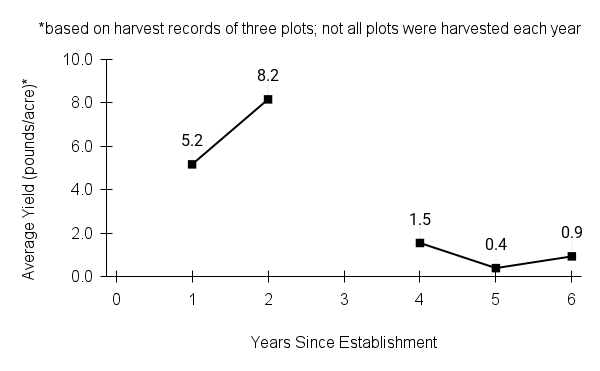 First harvest: Plants remain vegetative first growing season. Some flowering and seed set in the second growing season from greenhouse grown transplants.
First harvest: Plants remain vegetative first growing season. Some flowering and seed set in the second growing season from greenhouse grown transplants.Yield: 0.4-8.2 bulk pounds/acre (yields extrapolated based on production from 3 plots); commercial growers can achieve yields of 20-50 pounds per acre (USDA Plants Guide)
Stand life: Stands are long-lived in proper soils/hydrology. Seed production declines as stands become sod-bound in approximately 4-5 years. Flowering is patchy within a stand and may be higher on the edges of clones.
Flowering date: mid to late June in northern Iowa
Seed maturity: early July in northern Iowa
Seed retention: Shattering occurs soon after maturity, and seed is windblown. Monitor frequently for ripeness and be ready to harvest when inflorescences turn pale, fluffy, and open. The glumes stay on the plant when the seed drops, so seed heads can appear full even after they have shed much of their seed.
Harvest date range at TPC (2003-2008): June 29 - July 10
Recommended harvest method: Hand harvest or combine at maturity, but before dispersal. The seed is very light and wind-dispersed. Turn off air when combining.
- Seed cleaning and storage
Cleaning process: Thresh hand-collected material through 1/4 in screen. Brush seed to remove tuft of hairs at base of florets to improve flow of seed through airscreen (see settings in Appendix C).
Seed storage: Cool/dry (33-50° F, 30-50% RH).
Released Germplasm
Source Identified material: Natural Selections/Iowa Ecotype Zones 1, 2, and 3
Cultivated variety (cultivars): Sourdough (AK)
- References
Alaska DNR. (2007). ‘Sourdough’ Bluejoint Reedgrass Calamagrosis canadensis. [Infographic]. dnr.alaska.gov. https://dnr.alaska.gov/ag/akpmc/pdf/plant-flyers/SourdoughBluejoint.pdf
Chayka, K. (n.d.). Calamagrostis canadensis (Canada bluejoint). Minnesota Wildflowers. https://www.minnesotawildflowers.info/grass-sedge-rush/canada-bluejoint
Hilty, J. (2019). Bluejoint grass - Calamagrostis canadensis. Illinois Wildflowers. https://www.illinoiswildflowers.info/grasses/plants/bluejoint.html
Houseal, G. A. (2007). Grasses cool season. In G. A. Houseal (Eds.), Tallgrass Prairie Center’s native seed production manual (pp. 82–83). Tallgrass Prairie Center - University of Northern Iowa.
Kartesz, J.T., The Biota of North America Program (BONAP). 2023. North American Plant Atlas. (http://bonap.net/napa). Chapel Hill, N.C. [maps generated from Kartesz, J.T. 2023. Floristic Synthesis of North America, Version 1.0. Biota of North America Program (BONAP). (in press)]
Marr, K. L., Hebda, R. J., & Greenef, C. W. (2021). Calamagrostis canadensis (Michx.) P. Beauv. Flora of North America. http://floranorthamerica.org/Calamagrostis_canadensis
NatureServe. 2024. NatureServe Network Biodiversity Location Data accessed through NatureServe Explorer [web application]. NatureServe, Arlington, Virginia. Available https://explorer.natureserve.org/. (Accessed: February 29, 2024).
Norton, D.C., Cody, A.M., Gabel, A.W. (1987) Subanguina calamagrostis and Its Biology in Calamagrostis spp. in Iowa, Ohio, and Wisconsin. The Journal of Nematology, 19(2), 260-262. https://pmc.ncbi.nlm.nih.gov/articles/PMC2618621/
USDA NRCS National Plant Data Team. (n.d.). Calamagrostis canadensis (Michx.) P. Beauv. USDA plants database. https://plants.usda.gov/plant-profile/CACA4
Wynia, R.L. (2006, March 07) Bluejoint Reedgrass Calamagrostis canadensis (Michx.) Beaux. USDA NRCS Plant Guide. https://plants.usda.gov/DocumentLibrary/plantguide/pdf/pg_caca4.pdf
Species Guide Updated 12/1/2025
prairie Junegrass
prairie Junegrass dickeye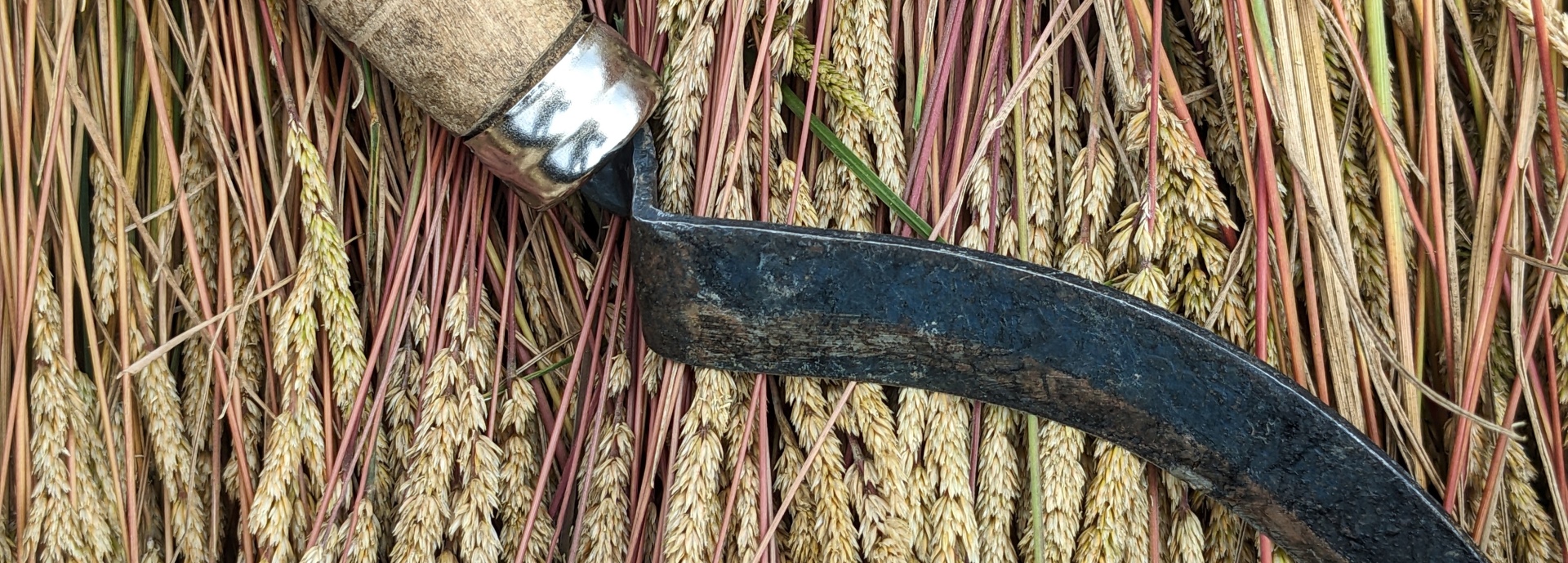
Koeleria macrantha (Ladeb.) Schult.
Alternate Common Names: June grass, Junegrass, crested hair grass, Koeler’s grass
Scientific Synonyms: Koeleria albescens auct., Koeleria cristata auct. non Pers. p.p., Koeleria cristata Pers. var. longifolia Vasey ex Burtt Davy, Koeleria cristata Pers. var. pinetorum Abrams, Koeleria gracilis Pers., Koeleria nitida Nutt., nom. utique rej., Koeleria pyramidata auct. non (Lam.) P. Beauv. p.p., Koeleria yukonensis Hultén, Koeleria nitita, Koeleria cristata Pers. var. pubescens, Koeleria cristata Pers. var. major
Family: grass family (Poaceae)
Functional Group: cool season grasses
Description
- Life cycle and growth form
Perennial, cool-season bunchgrass with fibrous roots.
Height: 0.5-2 ft
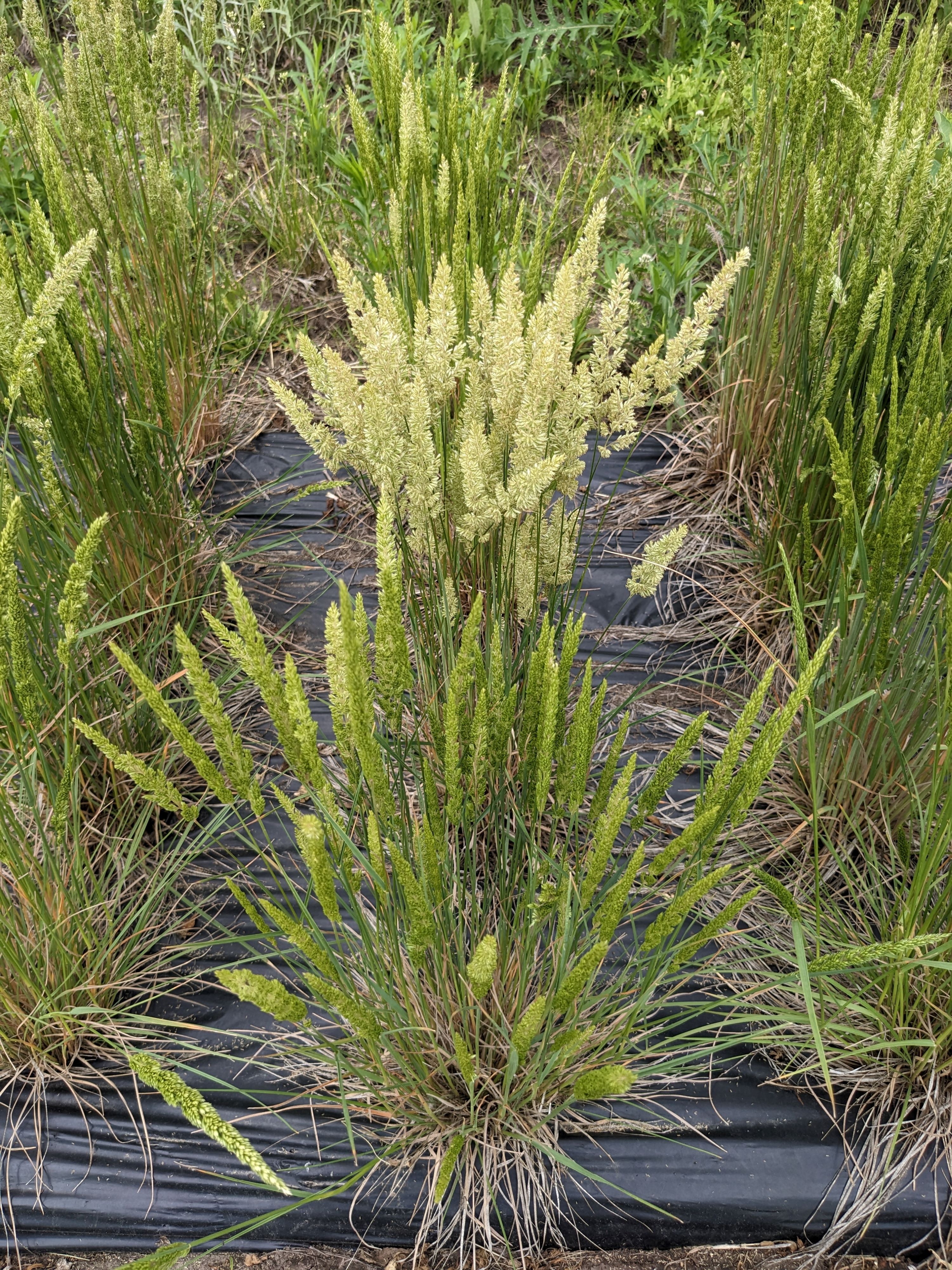
- Leaves and stem
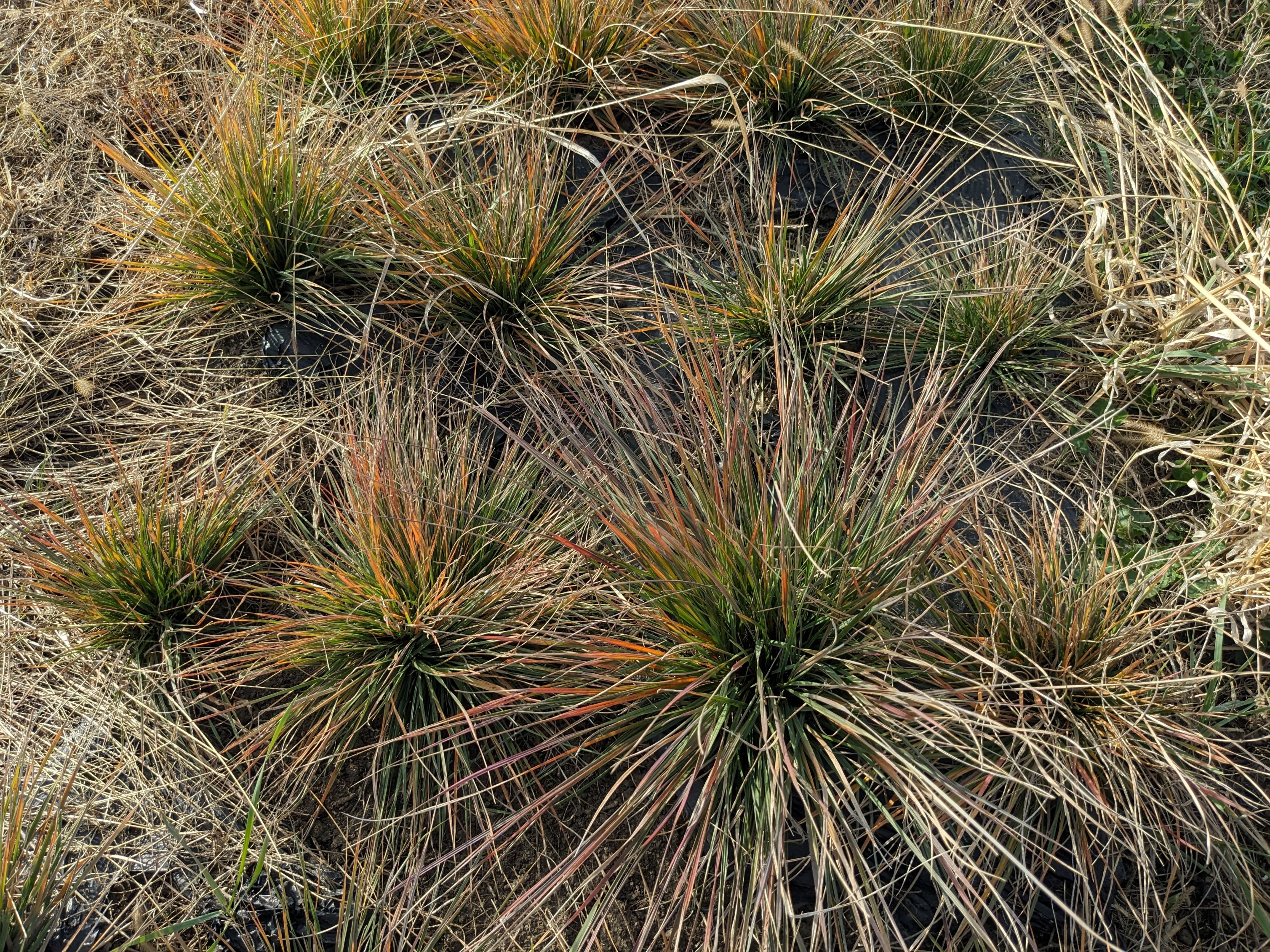
Leaves mostly basal in a distinct tuft, leaf blades 3-25 cm long (1.25-10 in) and 1-4 mm wide (up to 3/16 in), leaf sheaths short-hairy to smooth, with hairs on the margins of the collar, ligule a short (<1 mm), ragged membrane; stem with fine hairs at base of seedhead and at nodes.
- Flower, fruit and seedhead
Fruit/seedhead: Light tan spike-like panicle 3-18 cm long (1.25-7.25 in) and 1-3 cm wide (0.5-1.25 in), stem covered in fine hairs below the seed head. At maturity, seed drops off with surrounding chaffy parts (lemma and palea), but glumes (chaffy parts below the flowers) stay on the stalk.
Pollination: wind
- Seed
Seed characteristics
Seed weight:
Seeds per ounce: 200,000 (IA NRCS)
Seeds per pound: 3,200,000 (IA NRCS)
1000 seed weight: 0.30 g (Seed Information Database)
Description: Seed unit is a grain about 2-3 mm long (1/8 in), with or without surrounding chaffy parts (lemma and palea).
Typical seed test
PLS: 69% (n = 10)
Purity: 76% (n = 10)
Germination: 68% (n = 9)
Dormant: 1% (n = 9)
(averages obtained from n tests of purchased seed lots)
- Habitat and range
Habitat: Full sun. Found in dry, upland, rocky or sandy prairies, becoming more abundant on northern prairies. Very well-drained soils are preferred for seed production.
Conservation status: Global- G5, secure; Pennsylvania- SX, presumed extirpated; Alaska, Kentucky, and Louisiana- S1, critically imperiled; Arkansas and Ohio- S2, imperiled; Nevada- S3, vulnerable (NatureServe)

General Comments
Prairie Junegrass is an important cool-season grass component, particularly in prairies on dry, very well-drained sites. Plants are of medium longevity, poorly tolerant of competition, and may rely on reseeding to persist.
Recommendations for Seed Production
- Establishment for seed production
Direct seeding
Row spacing: 36 in 24 in 12 in Solid Stand PLS lbs/acre: 0.25 0.4 0.75 0.75-1.0 Seeding depth: 1/8 in (light needed for germination)
Seeding method: native seed drill
Seeding time: Late spring
Weed control: Good weed control before seeding is essential. Seedlings are small and slow growing and vulnerable to competition from weeds as well as to mechanical damage from equipment or foot traffic.
Greenhouse
Seed pre-treatment: No stratification necessary, although we have observed improved speed and uniformity of germination following 30-day cold/moist stratification. Germination of grass seed usually improves with proper storage (cool, dry conditions) throughout the first year after harvest.
Sowing: Sow seed on top of soil (or cover only very lightly, seeds require light to germinate) in a greenhouse 8-12 weeks before the last frost free date. Water (or mist) very gently to avoid splattering or floating seeds out of the potting medium.
Transplanting: Transplant into a weed barrier 8-12 in apart after all danger of frost.
- Stand management
Weeds: For plantings in weed barrier, hand rogue weeds while small, being careful not to uproot young seedlings. For direct seeded stands, mow stand high (6–12 inches) in first growing season to prevent weed canopy from shading seedlings. Cultivate or mow vegetation between rows. Broadleaf herbicides can be used to control broadleaf weeds in established stands. Non-native perennial cool-season grasses such as Kentucky bluegrass (Poa pratensis) and smooth brome (Bromus inermis) invade plantings and can outcompete Junegrass, causing declines in production.
Pests: Grubs are reportedly a problem in Texas.
Diseases: Ergot is known to occur on seedheads.
- Seed production
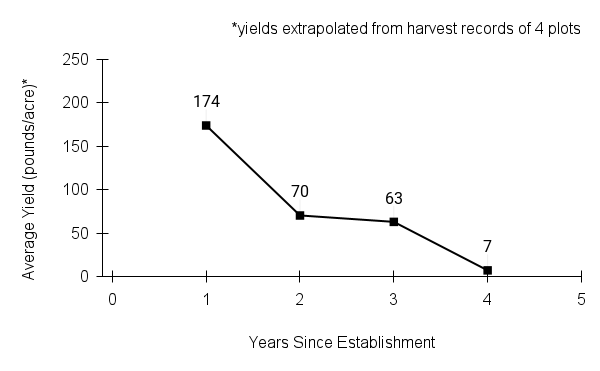 First Harvest: Flowering and seed set at end of second growing season from greenhouse grown transplants. Plants will remain vegetative the first growing season.
First Harvest: Flowering and seed set at end of second growing season from greenhouse grown transplants. Plants will remain vegetative the first growing season. Yield: 10-175 pounds/acre (averages extrapolated from 3 plots)
Stand life: Potentially 4-5 years. Peak harvests occur in second and third year, after which seed production declines significantly. Invasion by non-native cool-season grasses is one cause of yield decline.
Flowering Date: early to late June in northern Iowa
Seed maturity/Harvest date: late June - early July in northern Iowa. Regularly monitor plots for maturity as seed heads change from green to straw colored. Tap seed heads lightly on hand and observe for shattering.
Seed retention: Shattering occurs mid to late July
Harvest date range at TPC (2003-2023): June 22 - July 8
Recommended harvest method: Combine harvesting is practical for larger plots. Swathing/windrowing before combining may improve threshing, uniformity of seed maturation, and reduce shattering due to wind. A modified hedge-trimmer with an attached collection tray works for harvesting small plots.
- Seed cleaning and storage
Cleaning process: Pre-clean air-dried material by scalping thru 1/2 in and 1/4 in mesh to remove large pieces of stems and leaves. Run through a brush machine to break up seed heads, then air-screen to clean (see appendix for settings).
Seed storage: cool/dry (33-50° F, 30-50% RH)
Released Germplasm
Source Identified material: Natural Selections/Iowa Ecotype Project Zone 1 (northern Iowa) and Zone 2 (central Iowa)
- References
Chayka, K. (n.d.). Koeleria macrantha (Junegrass). Minnesota Wildflowers. https://www.minnesotawildflowers.info/grass-sedge-rush/junegrass
Hilty, J. (2019). June grass - Koeleria macrantha. Illinois Wildflowers. https://www.illinoiswildflowers.info/grasses/plants/june_grass.htm
Houseal, G. A. (2007). Grasses cool season. In G. A. Houseal (Eds.), Tallgrass Prairie Center’s native seed production manual (pp. 88–89). Tallgrass Prairie Center - University of Northern Iowa.
Kartesz, J.T., The Biota of North America Program (BONAP). 2023. North American Plant Atlas. (http://bonap.net/napa). Chapel Hill, N.C. [maps generated from Kartesz, J.T. 2023. Floristic Synthesis of North America, Version 1.0. Biota of North America Program (BONAP). (in press)]
NatureServe. 2024. NatureServe Network Biodiversity Location Data accessed through NatureServe Explorer [web application]. NatureServe, Arlington, Virginia. Available https://explorer.natureserve.org/. (Accessed: February 29, 2024).
Runkel, S. T., & Roosa, D. M. (2009). June grass. In Wildflowers of the tallgrass prairie: The upper Midwest (2nd ed., pp. 106–107). University of Iowa Press.
Standley, L. A. (2021, May 11). Koeleria macrantha (Ledeb.) Schult. Flora of North America. http://floranorthamerica.org/Koeleria_macrantha
USDA NRCS National Plant Data Team. (n.d.). Koeleria macrantha (Ledab.) Schult. USDA plants database. https://plants.usda.gov/home/plantProfile?symbol=KOMA
Species Guide Updated 12/04/2025
